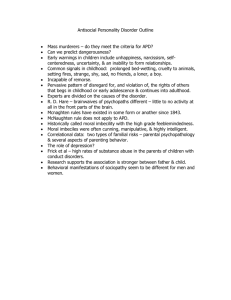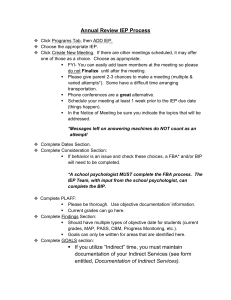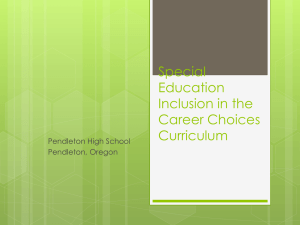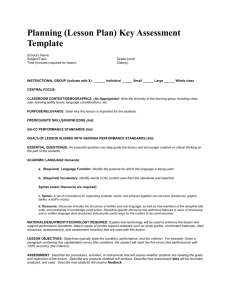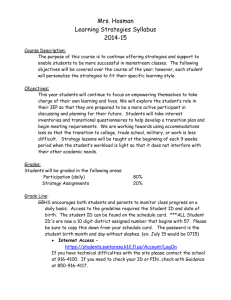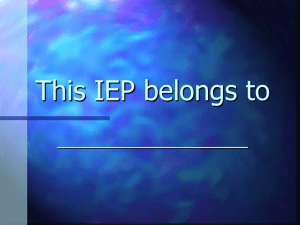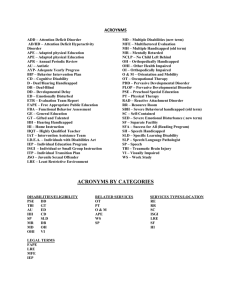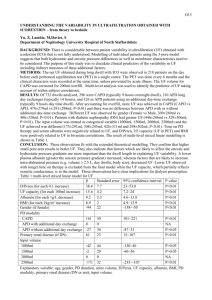teacher questionnaire
advertisement
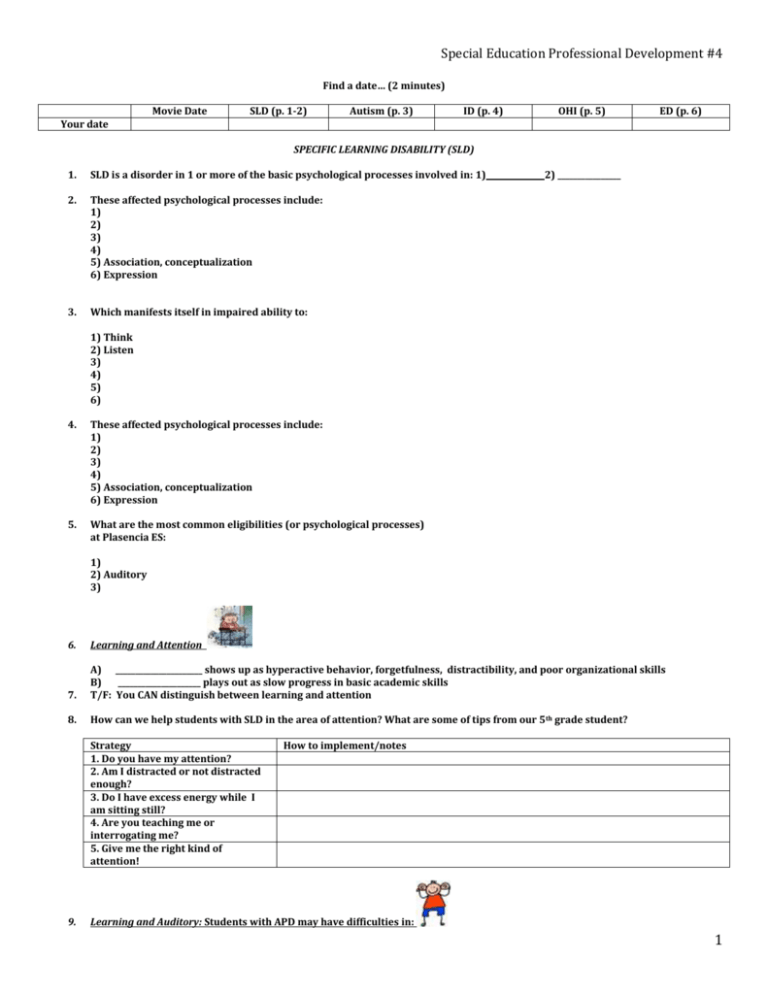
Special Education Professional Development #4 Find a date… (2 minutes) Movie Date SLD (p. 1-2) Autism (p. 3) ID (p. 4) OHI (p. 5) ED (p. 6) Your date SPECIFIC LEARNING DISABILITY (SLD) 1. SLD is a disorder in 1 or more of the basic psychological processes involved in: 1) 2. These affected psychological processes include: 1) 2) 3) 4) 5) Association, conceptualization 6) Expression 3. Which manifests itself in impaired ability to: 2) ________________ 1) Think 2) Listen 3) 4) 5) 6) 4. These affected psychological processes include: 1) 2) 3) 4) 5) Association, conceptualization 6) Expression 5. What are the most common eligibilities (or psychological processes) at Plasencia ES: 1) 2) Auditory 3) 6. Learning and Attention 7. A) ______________________ shows up as hyperactive behavior, forgetfulness, distractibility, and poor organizational skills B) _____________________ plays out as slow progress in basic academic skills T/F: You CAN distinguish between learning and attention 8. How can we help students with SLD in the area of attention? What are some of tips from our 5 th grade student? Strategy 1. Do you have my attention? 2. Am I distracted or not distracted enough? 3. Do I have excess energy while I am sitting still? 4. Are you teaching me or interrogating me? 5. Give me the right kind of attention! 9. How to implement/notes Learning and Auditory: Students with APD may have difficulties in: 1 Special Education Professional Development #4 1. 2. 3. Telling the difference between similar sounding speech 10. In school, children with APD may difficulties in: 1. 2. 3. Verbally presented information 11. Students with APD will do well in school if 1. Performance does not rely on _____________ 2. If they know what is expected of them 11. Accommodations/modifications for students with APD: School age children Combine _________ with __________ Ask that teachers and others make it physically, visually or audibly clear when they are about to begin Have a note-taking buddy who will make sure that information was understood; Request seating close to teacher; Have child repeat back information or instructions to build comprehension skills 12. Learning and Visual 1) visual discrimination: The Skill—Using the sense of sight to notice and compare the features of different items to distinguish one item from another. Difficulties Observed Seeing the difference between two similar Letters, shapes or objects Noticing the similarities and differences between certain colors, shapes and patterns Types of Helpful Strategies Clearly space words/problems on a page. Anticipate c______________ and point out examples of correct responses 2) visual figure – ground discrimination: The Skill—Discriminating a shape or printed character from its background. Difficulties Observed Finding a specific bit of information on a printed page full of words and numbers Seeing an image within a competing background Types of Helpful Strategies Practice with ‘find the item’ challenges, such as “______________?” Use an index card or marker when reading to blot out distraction of other words. Highlight useful information while reading. 3) Visual Sequencing The Skill—The ability to see and distinguish the order of symbols, words or images. Difficulties Observed Using a separate answer sheet Staying in the right place while reading a paragraph. Example: skipping lines, reading the same line over anover Reversing or misreading letters, numbers and words Understanding math equations Types of Helpful Strategies Combine reading with O__________ P__________ and Color code written instruction. Autistic Like Behaviors 2 Special Education Professional Development #4 In order to qualify for Autistic behaviors – student must exhibit _______ or more of the following: 1. An inability to use ___________ & __________ language for appropriate communication and social interaction 2. History of extreme withdrawal relating to people inappropriately & continued impairment in social interaction from infancy to childhood Obsession to maintain sameness such a resistance to environmental changes or daily routines Extreme preoccupation with objects or inappropriate use of objects or both Extreme resistance to control Displays peculiar mannerism and patterns such as repetitive activity, & stereotype movement Self-stimulating ritualistic behaviors 3. 4. 5. 6. 7. How can we help students with Autism Strategy 1. Keep it structured: 2. Use visuals: How to implement/notes Establish a routine because students in the spectrum thrive in routine. 3. Use Schedules: 4. Reduce distractions: 5. Use concrete language 6. It’s not personal 7. Transitions: 8: Establish independce: 9. Rewards and consequences 10. Teach with lists: 11. Don’t sweat the small stuff: 3 Special Education Professional Development #4 Intellectual Disability (ID) An Intellectual Disability… 1. Is a student who has significantly below average general intellectual functioning existing concurrently with deficits in adaptive behavior and manifested during the developmental period, which affects the students’ educational performance. 2. The student demonstrates significantly below average intellectual ability 3. The student demonstrates deficits in two or more adaptive behaviors (communication, home living, community use, health and safety, leisure, self-care, social skills, self direction, functional academics, and/or work. 4. The deficits were manifested during the D___________ P_____________. 5. The deficits affect the student’s educational performance and require special education to meet the student’s needs. How to help students with ID Strategy How to implement/notes 1. Recognize that you make a difference with this student’s life 2. Be an active participant in student’s IEP 3. Provide accommodations 4. Be as concrete as possible 5. Go step by step 6. Give immediate feedback 7. Help student learn life skills 8. Address social aspect of school 9. Communicate with your student’s parents 4 Special Education Professional Development #4 Other Health Impairment (OHI) Student with OHI eligibility has limited strength and vitality or alertness due to chronic or acute health problems, which adversely affects the students’ academic performance. For example… 1. A______ ______ 2. S______ 3. E______ 4. C______ 5. Recovering from a surgery and many more… How to help student with OHI eligibility… . Refer to student’s IEP because eligibilities and accommodations will vary! 5 Special Education Professional Development #4 Emotional Disturbance (ED) Emotional Disturbance… Is a student that shows one or more of the following Characteristics over several Situations that has existed over a long period of time ,which affects the students’ Educational performance: 1. An inability to learn which cannot be explained by Intellectual, sensory or other health factors. For Example: disorganized thought process, Schizophrenia, distorts reality, or underlying Psychiatric disorder. 2. An inability to build or maintain satisfactory Interpersonal relationships with peers and teachers 3. Inappropriate types of behavior under normal Circumstances (fear, anxiety) 4. General pervasive mood of u_________ or d__________ 5. Tendency to develop physical symptoms or fears associated with personal and school problems. How to help students with ED… Strategy 1. Learn about student’s mental health 2. Learn about student’s strengths 3. Remember they’re kids first 4. Support the student’s inclusion (we skipped this on our movie How to implement/notes Emotional disturbances, by their very nature, can make it difficult for people to build or maintain satisfactory interpersonal relationships. You can support the student with an emotional disturbance in subtle but meaningful ways, especially during group work, cooperative learning activities, peer interactions, and team projects. There may also be times to let the student work alone, take a break, or have a hall pass for some quiet time apart. 5. set clear behavioral rules and expectations 6. Provide accommodations 7. lastly, join student’s IEP and communicate with student’s parents 6
